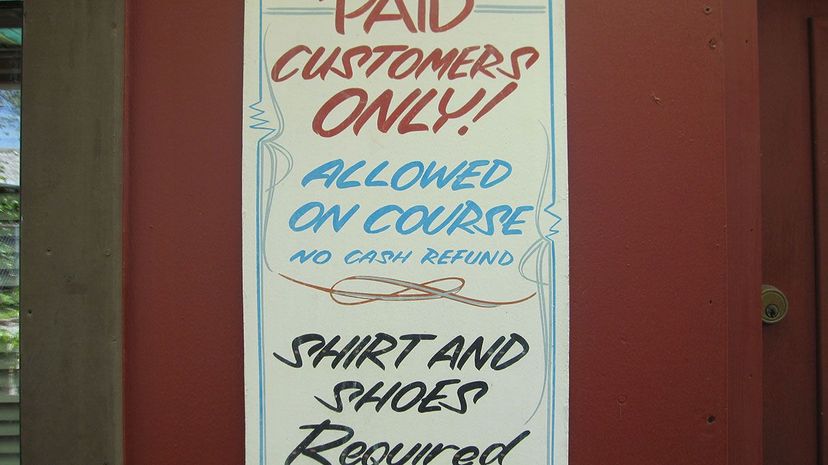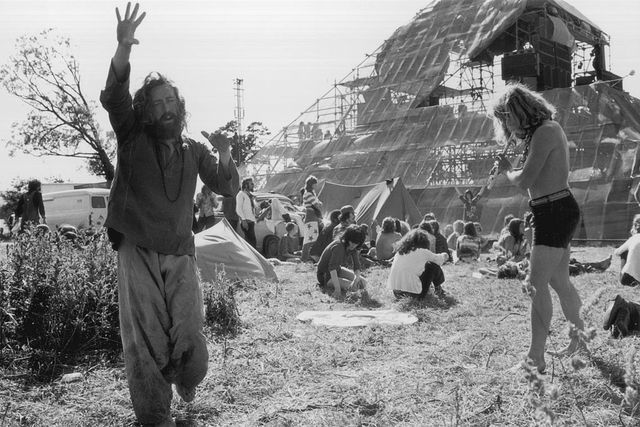
You ever walk into a store or restaurant and seen the sign "No shirt, No shoes, No service" on the door? (Sometimes it's expressed in the positive: "Shirt and Shoes Required.") Where did that come from? And why doesn't the policy cover something more basic — like pantslessness?
We set about to research the origins of the "No shirt, No shoes, No service" sign and came up with an interesting, if still unofficial history.
Advertisement
The leading theory is that the signs rose to prominence in direct opposition to the counterculture movement of the 1960s. The Society for Barefoot Living blog posited that the signs didn't even exist until 1970, but "spread like wild-fire" as more business owners looked for ways to keep out those long-haired, tie-dyed, barefooted hippies.
We reached out to William Rorabaugh, history professor at the University of Washington and author of "American Hippies," to see if the anti-hippie theory rang true. Rorabaugh agreed that the "No shirt, No shoes, No service" signs would certainly have been used by business owners who thought hippies were undesirable patrons.
A columnist for a Eugene, Oregon paper wrote in 1972, "Hippies have taken over the north end of town and the business people don't like it. They have signs saying shoes and shirts are required – no entrance to bare feet."

Some signs of the times were even more blunt. "There were other signs like 'No long hairs,'" says Rorabaugh, clarifying that the sign targeted men. "One of the other things that started around 1970 were the 'Please wait to be seated' signs. Before that, only a very fancy restaurant might say, 'Please wait to be seated,' but in an ordinary restaurant, you just went in and sat down wherever you wanted. But once there were long-haired people, out came the 'Please wait to be seated' signs."
While the "No shirt, No shoes, No service" signs definitely experienced an explosion in the early 1970s, it doesn't mean that they never existed before. Rorabaugh, the historian, notes that the signs were everywhere when he was growing up in coastal Florida in the 1950s.
Beach communities, much more than the rest of the country, have a long history of dealing with shirtless and shoeless customers. When Rorabaugh was a kid in the 1950s, the culture at large was far more formal. He says that almost all restaurants, even beachside snack bars, required shirts and shoes to order food. Contrast that with the sign you're much more likely to find at beachside bars in Florida today: "No shirt, No shoes, No problem!"
What's clear from the history of the "Shirt and Shoes Required" sign is that it never had anything to do with enforcing health codes, despite the fact that several early versions of the sign included the addendum, "By order of the Board of Health."
In fact, no U.S. state has a law requiring restaurant patrons wear shoes. The Society for Barefoot Living went to the trouble of including copies of letters from every state department of health in the country saying that while food service employees must wear "proper attire," there are no rules for patrons.
Does that mean that it's illegal for a business owner to refuse to serve someone without a shirt or shoes? Not exactly. A private business owner is allowed to enforce their own dress code as long as it's not discriminatory.
According to LegalZoom, the 1964 Federal Civil Rights Act prohibits any place of public accommodation – which includes private businesses like restaurants, hotels and stores – from refusing to serve a customer based on race, color, religion or national origin. The Americans With Disabilities Act extends the anti-discrimination coverage to people with disabilities. Although dozens of states offer similar protections for LGBTQ residents, there is no such federal law.
What this means is that it's perfectly legal for a business owner to kick out a customer not wearing shoes as long as the owner consistently enforces the same rule for all shoeless customers. The business owner is also within his or her rights to refuse service to someone with extreme body odor, who is intoxicated, or is acting in a rowdy manner, among other things.
So, next time you hustle down to the corner store for some late-night Doritos, put on some darn slippers.
Advertisement
